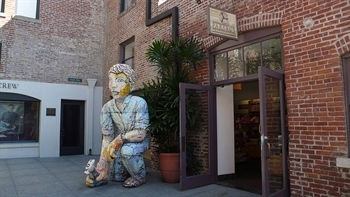See all the articles in the Solving the Parking Predicament series. >>
MPC research assistant Lena Ferguson authored this post.
Old Pasadena, the downtown core of Pasadena, Cali., perhaps is the best example of how managing parking can have a profound, place-changing effect on urban areas. Once an elegant shopping district, with beautiful Spanish Colonial Revival and Art Deco facades dating to the 1920s, after the Great Depression Old Pasadena became a disinvested skid row that by the 1970s and 1980s was filled with pawn shops, adult theaters, and vacant buildings. Today, Old Pasadena’s downtown is one of southern California’s most popular entertainment and shopping destinations, all due to a bold parking management strategy.

Today, Old Pasadena’s downtown is one of southern California’s most popular entertainment and shopping destinations, all due to a bold parking management strategy.
Photo courtesy of Flickr member Benjamin Page
Before 1993, Old Pasadena had no parking meters, and on-street parking was restricted only by two-hour parking limits. Because parking was free, customers had difficulty finding places to park, in part because store employees used the on-street parking, moving spots every two hours to avoid fines. Still, the idea to install meters was met with trepidation. Store owners were worried that paid parking would drive away potential customers, a common concern when parking meters are proposed. In reality, meters are good for business, as people who would pay to park outside a store – usually, people most interested in making a purchase there – would be able to get a space, instead of wasting those spaces on employees or other non-shoppers. The turning point of the parking meter debate in Old Pasadena was largely the brainchild of then- Mayor Rick Cole, elected in 1992. Cole suggested using the meter revenue in the metered areas to improve the streetscape, instead of marking meter revenue for the city’s general fund. Store owners agreed because they liked the idea of cleaning up the area, making it more attractive to customers.

By the 1970's and 1980's Old Pasadena had become a disinvested skid row.
In 1993, coupled with the parking meter installation, the city borrowed $5 million for the “Old Pasadena Streetscape and Alleyway Project,” with the future meter revenue dedicated to repaying the debt – a commitment that the revenue would stay in Old Pasadena. A marketing campaign included signs on the meters telling shoppers their meter money would support neighborhood revitalization. The Old Pasadena Streetscape and Alleyway Project paid for initial repairs to dilapidated alleyways and sidewalks, and installation of trees and tree grates, street furniture, and historic lighting fixtures. At the same time, the city also worked with Old Pasadena’s existing Business Improvement District (BID) – a defined area where businesses pay an special tax to fund improvements in that same area – to establish the downtown’s Parking Meter Zone (PMZ), so that only areas with meters would receive the revenue benefits. They also established a PMZ Advisory Commission of business and property owners, who recommend parking policies and identify priorities for using the meter revenue.
Meter pricing in Old Pasadena is managed to reflect parking demand, a best practice in parking policy. More than 1,200 meters are enforced seven days a week from 11 a.m. to 8 p.m. Sunday through Thursday, and 11 a.m. to midnight Fridays and Saturdays. Parking is not allowed between 2 a.m. and 6 a.m. The meter cost varies by location, with $1.25 per hour in the heart of Old Pasadena, where most people visit, and 75 cents per hour elsewhere. The meters do not have time restrictions because the fees encourage relatively quick parking spot turnover. Even if a customer chooses to park on-street for an extended period, the area still benefits from both the meter revenue and because the customer is likely spending more money in Old Pasadena businesses. It’s notable that the meter rates work in tandem with Old Pasadena’s publicly owned garages, which are open 24/7 and are free for the first 90 minutes and cost $2 per hour thereafter, with a $6 daily maximum. These rates make the garages more economical than on-street for long-term parking, which in turn eases traffic congestion and makes more on-street spots available for those who want them most.

Street art in Old Pasadena.
Photo courtesy of Flickr member Tiffany1985.
The overwhelming success of Old Pasadena’s parking management strategy has resulted in an attractive and safer place for customers and shop owners alike. In the first year, parking meter revenues yielded $1.2 million and by 2011, almost $1.5 million. These revenues pay for services in the PMZ, such as daily street and sidewalk sweeping, trash collection, removal of decals from street fixtures, bi-monthly steam-cleaning of sidewalks, and additional police department foot and horseback patrols, all at no cost to the city or taxpayers ($415,022 of 2011 revenues went to repay the initial “Old Pasadena Streetscape and Alleyway Project” loan, which will be completely paid in 2019.) Customers have flocked to Old Pasadena: Sales tax revenue has increased since the meters were installed and, as of 2003, surpassed the other retail districts in the city, even those with free parking.
Transforming Old Pasadena from a place to avoid to a place to enjoy would have been impossible without the parking meters. It’s a great model for replication in municipalities across the Chicago region, especially those with downtown business districts. As Marilyn Buchanan, who has served as chair of Old Pasadena’s PMZ Advisory Committee, said, “We’ve come a long way. This might seem silly to some people, but if not for our parking meters, it’s hard to imagine that we’d have the kind of success we’re enjoying. They’ve made a huge difference.”
MPC’s Solving the Parking Predicament series will highlight parking management theories, and ways in which cities across the country are using demand pricing, zoning requirements, and a little rethinking to better manage land dedicated to parking.

Movies in the square in Old Pasadena.